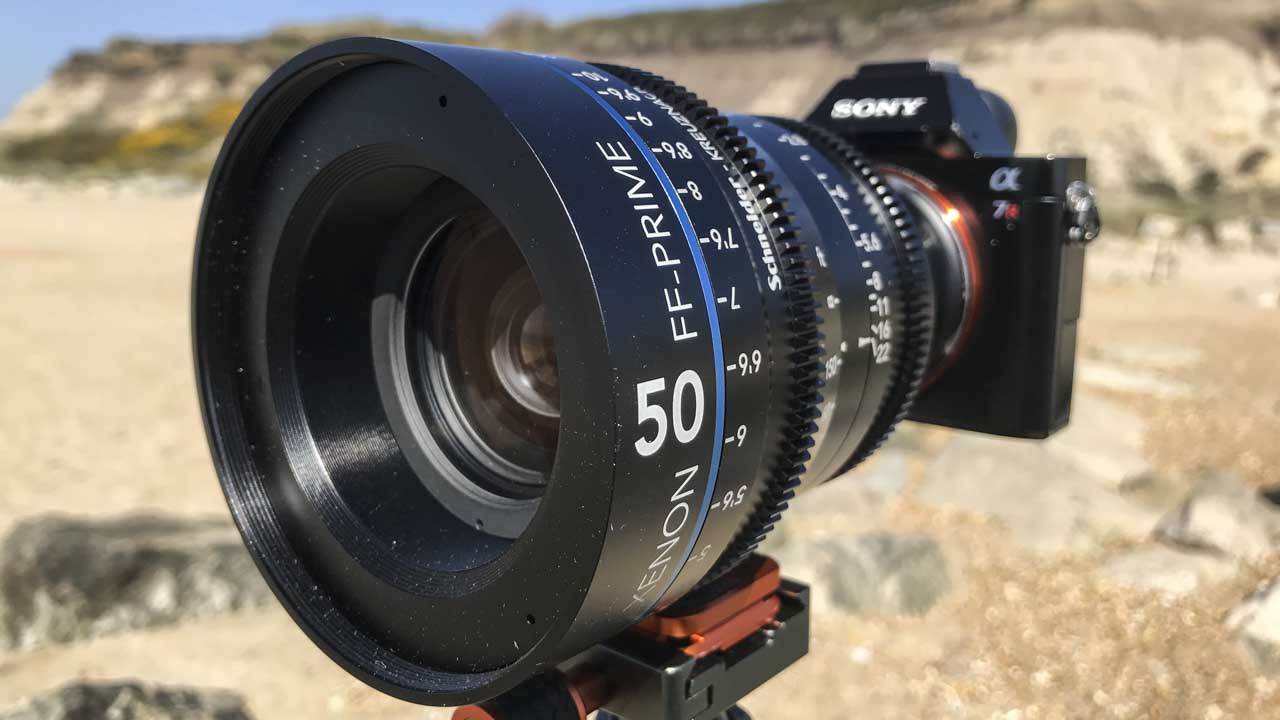Schneider 50mm T2.1 Xenon Snap Verdict
The Schneider 50mm T2.1 Xenon is a dedicated video lens. It’s full metal construction and design instantly gives you the confidence to shoot great video.
You may gorp at the £3000/$3000 plus price tag, especially when you consider that this lens is manual, with no AF, but what you’re paying for is absolute optical precision.
Designed exclusively for video, the design and make-up of the lens is starkly different from that of a stills lens, and this is mirrored in its design and construction that shows it’s movie heritage.
Focus and T-Stop rings are both silky smooth and geared so it can be incorporated into a more extensive manual or electronic rigs, and on the underside is a thread so the lens can be directly tripod mounted.
Optically you can instantly see the difference between this and a standard still lens, colour reproduction is rich and vibrant, and the large T2.1 iris produces stunning background bokeh.
If you’re stepping up your video production, then there’s no avoiding the inevitable need for the precision that only a dedicated video lens will give you.
As stills photographers, we may be stunned by the price, but believe me, this is an absolute bargain.
For Schneider 50mm T2.1 Xenon
- Metal construction
- Precise T-Stop control
- Fully optimised video lens
Against Schneider 50mm T2.1 Xenon Review
- No AF (Auto Focus)
- Manual Focus assist won’t work on older cameras
- Well priced but still expensive
DSLRs and Mirrorless cameras have become ideal for shooting movies; they’re compact, easy to use and produce excellent results. Best of all compared with pro video equipment they’re relatively inexpensive.
Schneider is well known for their optics and this latest range is being distributed by Manfrotto. There’s a full range of focal lengths; 18mm, 25mm, 35mm, 50mm, 75mm and 100mm all specially designed for the burgeoning DSLR video market.
These lenses are available for Nikon, Canon, PL and Sony systems with two versions for each fit.
The difference between that two versions are the measurements printed on the exterior which can be either in feet or meters. Our 50mm Sony E-Mount review version was in ft.
The reason that these markings are so important is that precision is essential when it comes to movie making. If you’re pulling focus then you don’t just charge into it, planning is required and rotation amounts between focal point A and B must be noted and then at the correct time through the script the embattled focus puller will delicately leap into action and shift the focus.
The choice between either feet or meters will be down to the operator or production.
These days the camera operator, focus puller, cable basher, grip and gaffer are generally all the same person, but still having these measurements on the lens is essential.
This attention to detail highlights the first of many stark differences between stills and video lenses. Although both types mount onto the front of your camera, when it comes to the inner workings they’re very different.
Features
The lens is a 50mm T2.1 lens, an excellent standard focal length for video as it is with stills. Aimed at the latest generation of videographers it has been designed for 4K capture and use with full-frame sensors, 36 x 24mm.
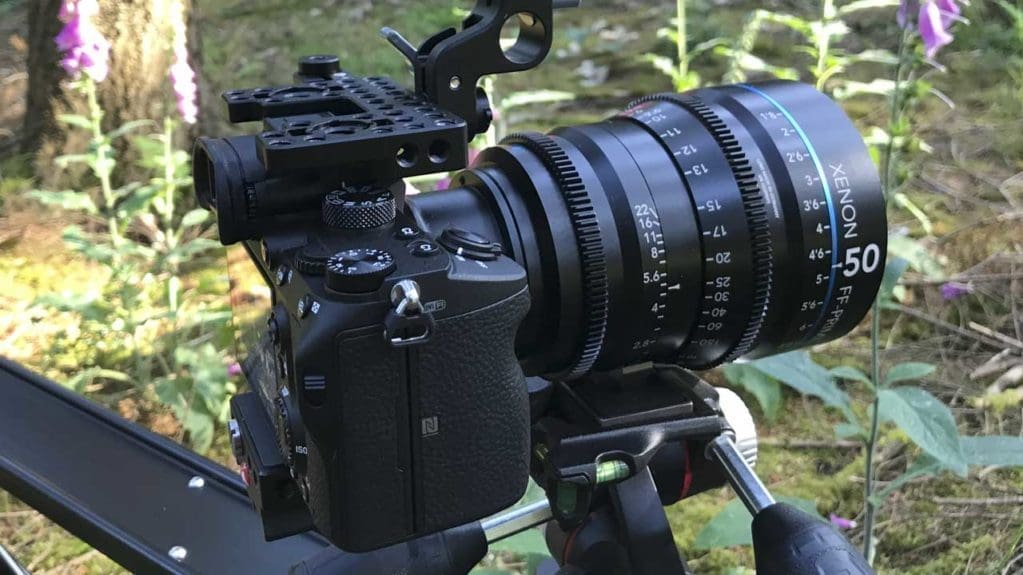
The construction is full metal, which adds to the quality feel, and the markings such as focal length, distance, T-Stop, as with all video lenses have their distinctive look and style that’s consistent whatever the manufacturer.
The distinguishing blue trim highlights that this is a Schneider lens.
Both the focus and T-Stop rings feature external geared teeth so that it can be easily incorporated into larger rigs and focus pullers or for that matter any other kit that you use.
Unlike a stills lens, the focus ring enables 300º of rotation for greater focusing accuracy.
On the underside of the lens is the 1/4-inch thread for the rig, slider or tripod mounting.
The lens enables a 40º angle of view and features 14 aperture blades. The size of the lens is considerably larger than your standard 50mm stills lens at 100 x 133.2mm with a 95mm filter thread.
95mm is a standard thread size for video lenses of this type.
The lens has a minimum focus distance of 50cm.
The lens is available in Nikon F fit, Canon EF, Sony E Mount and PL all in meter or Feet options.
Build quality and handling
Solid and stunning would sum up the Schneider 50mm T2.1 Xenon very nicely. The difference between this and even the G-Master lenses that I’m using with the Alpha 7 are a world apart.
This is down to the absolute precision required by video. I’ve already explained about the focus markings and why there needs to be an option for both feet and meters due to personal preference.
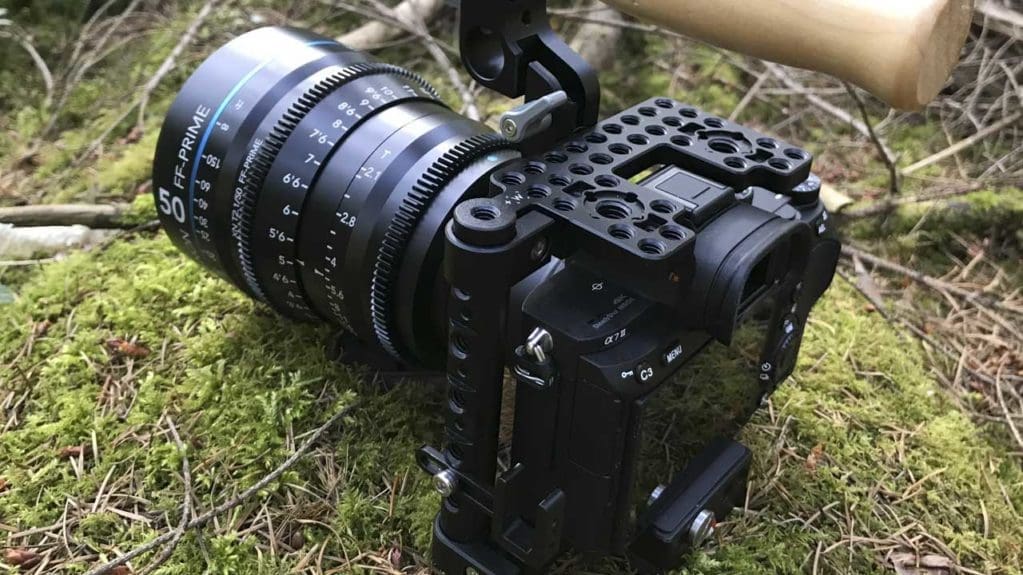
That same attention to detail and precision is also apparent across the rest of the lens design.
Staying with the focus, the rotation of the ring is as smooth as they come and it needs to be as any vibration will instantly be highlighted in the footage, and any shot that is underway would need to be reshot.
Stills photographers will at first find the focus a little odd to use as there’s a vast 300º rotation from 0.5m through to infinity, far more than you’d see on a standard stills lens.
The focus mechanism is also direct, no electronics, so you get a real feeling for the focus adjustment, and the external gears mean that once attached to a rig and focus puller you have absolute accurate control.
The T-Stop ring, not to be confused with the aperture ring, although substantially the same, follows the same lines as the focus ring. Smooth rotation so light can be controlled during the shot. Again there are markings on the side that clearly show the T-Stop value as the ring is adjusted.
Once fitted the lens instantly elevates your camera aesthetically, the lens is stunning to look at and tactile, you instantly want to get out and use it. But, looks are one thing and will be all bar pointless if it can’t provide performance and quality above that of a small standard 50mm stills lens.
Performance
The handling of your camera will change the instant the Schneider 50mm T2.1 Xenon lens is attached.
On our review sample fitted to a Sony Alpha 7 MK III the size and weight instantly meant that the camera felt more comfortable on a rig, tripod or slider than being handheld.
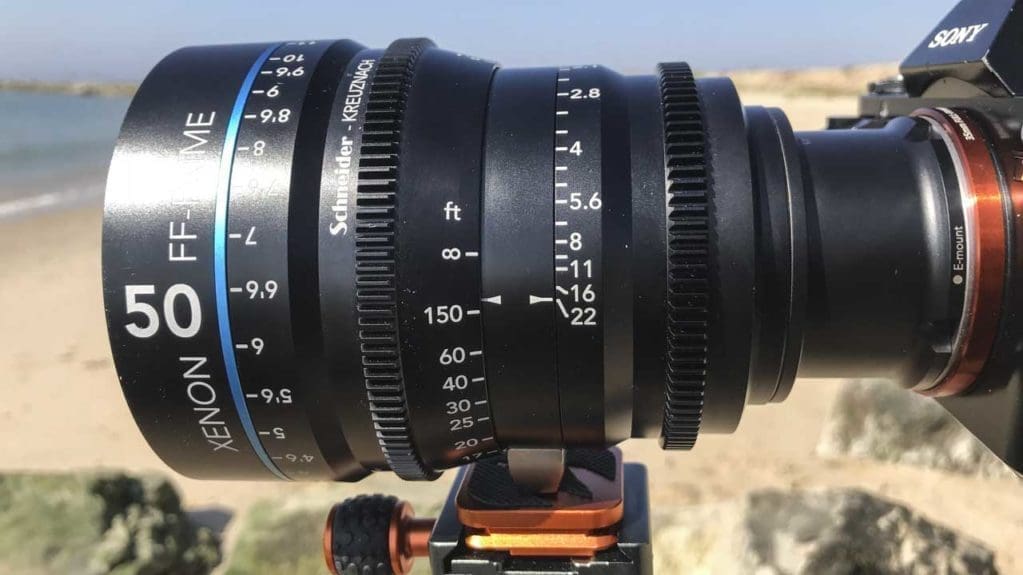
With video unlike stills, this is generally the case, and once mounted to a rig, tripod of slider then the balance was restored.
During the test the lens was used on a couple of Alpha 7 bodies, an older A7R MK I and the new A7 MK III. While the lens worked well on the A7R MK I the updated features of the updated camera shone through.
Manual focus assist is, of course, essential and with the added assistance of peaking finding focus was was comfortable enough, and the broad scope of that 300º focus rotation meant that adjusting the focus accurately was exceptionally easy, far more comfortable than when using a stills lens.
During filming the ease of defocusing or focusing without causing vibration or movement was far easier than when using a stills lens, and with the camera mounted solidly on a set of Manfrotto 545B legs there was no fear of instability from the tripod itself.
As with focus adjusting the T-Stop was again smooth. T-Stop is used in cinematography over aperture stops as it’s an accurate measure of the light that passes through the aperture in relation to the focal length.
While this is also true for stills the accuracy required for video is far higher, the result of this is that the effect of issues such as focus breathing is minimalised.
Breathing is common with all lenses and primarily refers to the adjustment of focal length as you focus.
When shooting stills this isn’t a huge issue as that small adjustment in focal length should go unnoticed. However, in the world of video, it can be a significant issue.
During the test, the focus at the minimum focal distance showed that breathing was indeed kept to a minimum.
I usually use the Sony 28-135mm lens for video. This is a dedicated video lens and produces a look and style that helps to elevate my video, as well as having features such as the power zoom that I find are a massive help when filming shots with added interest.
Although the Sony lens is dedicated, it’s a halfway house between stills and video. It’s a great all-rounder for general use, but then when using the Schneider 50mm T2.1 Xenon, it instantly highlights the differences in quality.
Manual focus on the Schneider 50mm T2.1 Xenon is sharp and direct; there’s no lag. T-Stop adjustment is smooth and not stepped like the Sony, and it is true T-Stop rather than aperture. The Schneider is a true cinematography lens.
After a good time looking at the mechanics of the lens it was time to review the footage.
With a maximum T-Stop of 2.1 this has to be the first point of call, and sure enough with the Iris wide open and the light flooding in the texture, tone and colour of the shots are fantastic. What stands out is the background blur which lives up to the claim on the Manfrotto site;
“The circular 14-blade aperture is specially engineered for a smooth and consistent bokeh.”
Looking across the frame and there is little to fault, there are no signs of distortion, and checking the high contrast edges for chromatic aberration seemed another pointless exercise.
The entire image from edge to edge is sharp, at least if you want it be and the focus shift is so smooth that you’d have to question your setup if a vibration does get through.
Contrast is well handled and using the A7 MKIII with the default colour mode did push the highlights, however, if you own this lens are you’re hardly going to be relying on default modes.
Switch to S-Log or simply toning down the contrast and after a touch of grading the footage stands outs. There’s no doubt that this lens gives you not only the full cinematic experience when it comes to filming but thankfully the look at the other end.
Verdict
When the Schneider 50mm T2.1 Xenon lens arrived it instantly struck appeal. The size design promoted instantly made me reminisce about an early life of filmmaking with old Super-16 and 35mm cameras.
The lens adds a sense of precision that you get with pro video gear.
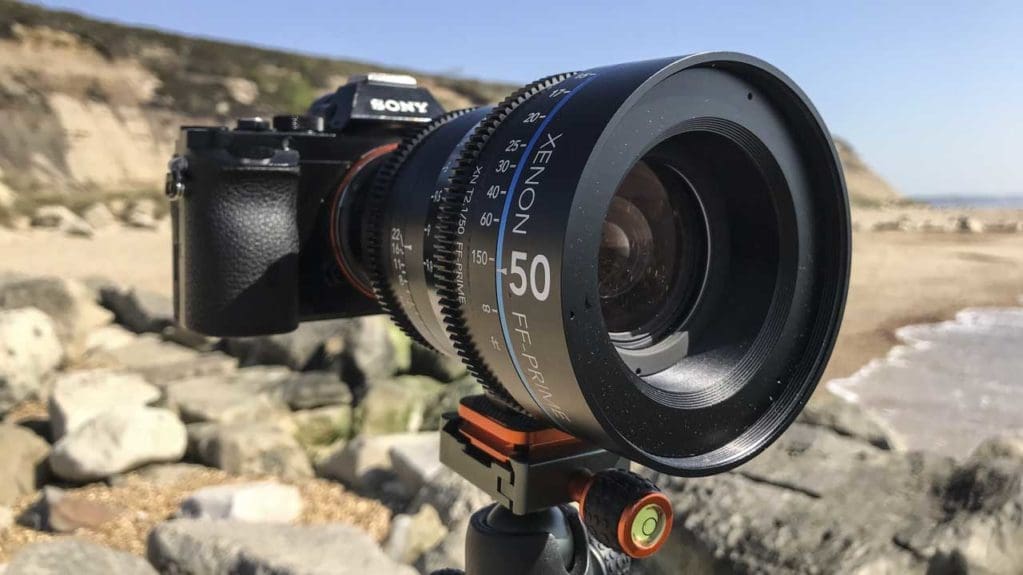
However, the fact that it was manual focus, weighty, and in many ways felt like a kickback to times past, meant that my initial feelings about the lens were in the balance.
Was the Schneider 50mm T2.1 Xenon an essential optic or just a lens to boost my ego?
Over the test period, I was as ever on an assignment or two, and the lens was packed in with the rest of my kit. I got it out for the odd shot or two at first, but then over time, it went from occasional, unusual use to become my primary lens.
It just took time for the old precision and pacing to come back to my filmmaking. Unlike stills, there is no shortcut; you can’t just turn-up, point and shoot and expect to capture true visually engaging footage. Everything should be planned, and if it is, then this lens excels.
The level of detail and tone of the final video image may not instantly be that much higher than that of my 28-135mm Sony, but there’s far more to this lens.
It’s the process of use. The focus ring is direct and sharp with that substantial 300º rotation that enables easy and accurate focusing.
The full integration with the latest camera systems, in our case the A7MIII, means that you have manual focus assist, peaking and zebra’s for the exposure.
I love the design but some may feel the look is a little dated, but there’s a reason and that’s due to consistency. The 95mm filter threads mean that all my ridiculously expensive filters screw in the front, the equally costly rig and slider are all fully compatible as is the teleprompt and Matt Box.
At first, I was in two minds about the value of a fixed prime that was essentially another £1000 on top of the price of my Sony 28-135mm.
After one use the benefits were starting to show, and after a month there was no doubt that at some point in the future when money allows, this, and the rest of the Schneider E-Mount lens range will be mine.
